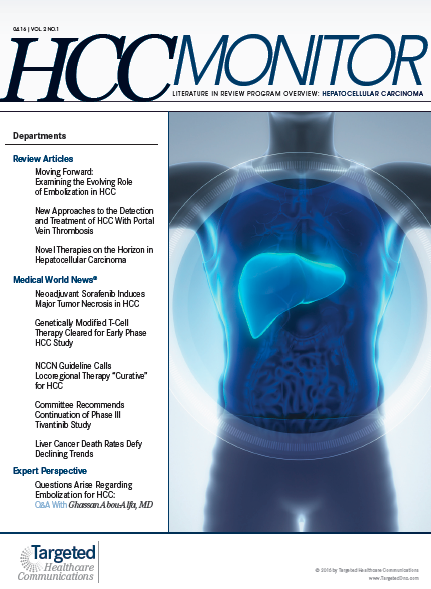Neoadjuvant Sorafenib Induces Major Tumor Necrosis in HCC
Roughly 25% of patients with resectable hepatocellular carcinoma (HCC) experienced major tumor necrosis following 4 weeks of preoperative treatment with sorafenib (Nexavar).
After the 4 weeks, paired tumor specimens from 6 of 25 patients (24%) exhibited ≥50% tumor necrosis formation. The objective response rate (ORR) by modified RECIST criteria was 32%, and by Choi criteria was 53%. Adding to these promising responses, the study showed increases in several biomarkers for angiogenesis in association with sorafenib.
“Even with the short period of exposure to sorafenib, we have a good number of patients with response,” said lead investigator Mohamed Bouattour, MD, assistant attending physician, Beaujon Hospital in Clichy, France. “We can say that necrosis occurred in at least 25% of patients in response to sorafenib. Even though sorafenib is not used preoperatively in clinical practice, we now know more about its mechanism of action, which we think applies to advanced HCC, as well as earlier HCC.”
The trial enrolled 28 patients; however, 3 developed toxicities leading to discontinuation, leaving 25 for analysis. The remaining 25 patients received a median daily sorafenib dose of 793 mg (range, 477-843 mg) for a median duration of 28 days.
The median age of patients in the trial was 62 years. Overall, 57% of patients had chronic liver disease, 36% had cirrhosis, and the remaining patients did not have an underlying disease. The median tumor size was 37 mm and 82% of patients had a single lesion.
The efficacy analysis included 19 patients. The ORR was 32% by modified RECIST criteria and the remaining 13 patients had stable disease (68%). By Choi criteria, the ORR in the 19 patients was 53% and the remaining 9 patients had stable disease (47%). Among responding patients, the median baseline tumor size was 48 mm, and 50 mm for those who met modified RECIST and Choi response criteria, respectively.
Posttreatment pathologic analysis of surgical specimens from all 25 patients showed macrovascular invasion in 12%, microvascular invasion in 52%, satellite nodules in 36%, good to moderate differentiation in 84%, necrosis of any degree in 68%, and necrosis of ≥50% or greater in 24%. The median tumor size of those with ≥50% necrosis was 48 mm.
In general, blood-based biomarkers associated with angiogenesis increased from baseline to the end of sorafenib treatment, including VEGF-A, VEGF-C, and PlGF. The only statistically significant increase from baseline to end of treatment occurred in PlGF (P = .04). The P values for changes in VEGF-A and VEGF-C were .23 and .61, respectively.
“When we examined the tumor specimens, we found that 68% of the patients had some evidence of tumor necrosis in response to sorafenib,” said Bouattour. “Another important point is that we did not find any evidence of resistance to sorafenib in this population.”
The most common dose-limiting toxicities with sorafenib were hand-foot syndrome, hypertension, diarrhea, and skin toxicity. Seven patients required dose reductions (29%), and 5 required temporary discontinuation (21%). No unexpected postoperative complications occurred. Four cases of transient ascites were the most notable complications, Bouattour reported. Two patients died following surgery, but neither death was related to the procedure.
References
- Bouattour M, Fartoux L, Rosmorduc O, et al. BIOSHARE multicenter neoadjuvant phase 2 study: Results of pre-operative sorafenib in patients with resectable hepatocellular carcinoma (HCC) From GERCOR IRC.J Clin Oncol. 2016;34(suppl 4S): Abstract 252.

Survivorship Care Promotes Evidence-Based Approaches for Quality of Life and Beyond
March 21st 2025Frank J. Penedo, PhD, explains the challenges of survivorship care for patients with cancer and how he implements programs to support patients’ emotional, physical, and practical needs.
Read More